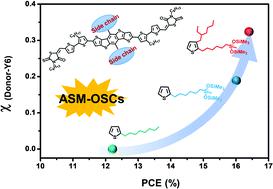当前位置:
X-MOL 学术
›
Energy Environ. Sci.
›
论文详情
Our official English website, www.x-mol.net, welcomes your
feedback! (Note: you will need to create a separate account there.)
Regulating phase separation and molecular stacking by introducing siloxane to small-molecule donors enables high efficiency all-small-molecule organic solar cells
Energy & Environmental Science ( IF 32.4 ) Pub Date : 2022-06-01 , DOI: 10.1039/d2ee00726f Yilin Chang 1, 2 , Xiangwei Zhu 3 , Yanan Shi 1, 2 , Yanan Liu 1 , Ke Meng 1, 2 , Yanxun Li 1, 2 , Jingwei Xue 4 , Lingyun Zhu 1 , Jianqi Zhang 1 , Huiqiong Zhou 1, 2 , Wei Ma 4 , Zhixiang Wei 1, 2 , Kun Lu 1, 2
Energy & Environmental Science ( IF 32.4 ) Pub Date : 2022-06-01 , DOI: 10.1039/d2ee00726f Yilin Chang 1, 2 , Xiangwei Zhu 3 , Yanan Shi 1, 2 , Yanan Liu 1 , Ke Meng 1, 2 , Yanxun Li 1, 2 , Jingwei Xue 4 , Lingyun Zhu 1 , Jianqi Zhang 1 , Huiqiong Zhou 1, 2 , Wei Ma 4 , Zhixiang Wei 1, 2 , Kun Lu 1, 2
Affiliation

|
For a long time, regulating the phase separation of all-small-molecule organic solar cells (ASM-OCSs) to achieve the ideal phase morphology has been a challenging problem in the field, in particular for the system composed of non-fullerene acceptors. In this work, we have constructed two small-molecule donors (ZR-SiO and ZR-SiO-EH) with low surface tensions by introducing siloxane. Based on the difference in the surface tension between a donor and an acceptor (Y6), an appropriate morphology with nanoscale phase separation was achieved in the blend system by regulating the intermolecular compatibility, thus effectively enhancing the photovoltaic performance of the corresponding ASM-OSCs. In particular, the ZR-SiO-EH:Y6 system exhibited a nanoscale bicontinuous interpenetrating network with a small domain size and face-on molecular stacking, which guarantees effective exciton dissociation and efficient charge transport even in the mixed region. In addition, the ordered molecular orientation, optimized morphology, and reduced energy offset between donors and acceptors reduce the non-radiative energy loss to 0.2 eV, leading to a high open circuit voltage of 0.87 V for ASM-OSCs. As a result, the ZR-SiO-EH:Y6 based device exhibited a high power conversion efficiency of 16.4%. These results demonstrate that regulating the intermolecular compatibility by siloxane to obtain ordered phase separation morphology provides an efficient method for designing high performance ASM-OSCs.
中文翻译:

通过将硅氧烷引入小分子供体来调节相分离和分子堆叠,实现高效全小分子有机太阳能电池
长期以来,调节全小分子有机太阳能电池(ASM-OCSs)的相分离以实现理想的相形态一直是该领域的一个具有挑战性的问题,特别是对于由非富勒烯受体组成的体系。在这项工作中,我们通过引入硅氧烷构建了两个具有低表面张力的小分子供体(ZR-SiO 和 ZR-SiO-EH)。基于供体和受体(Y6)之间表面张力的差异,通过调节分子间相容性在共混体系中实现了具有纳米级相分离的适当形貌,从而有效地提高了相应ASM-OSCs的光伏性能。特别是,ZR-SiO-EH:Y6 系统表现出纳米级双连续互穿网络,具有小域尺寸和正面分子堆叠,即使在混合区域也能保证有效的激子解离和有效的电荷传输。此外,有序的分子取向、优化的形态和减少的供体和受体之间的能量偏移将非辐射能量损失降低到 0.2 eV,导致 ASM-OSC 的开路电压高达 0.87 V。结果,基于 ZR-SiO-EH:Y6 的器件表现出 16.4% 的高功率转换效率。这些结果表明,通过硅氧烷调节分子间相容性以获得有序的相分离形态,为设计高性能 ASM-OSCs 提供了一种有效的方法。并且减少供体和受体之间的能量偏移将非辐射能量损失降低到 0.2 eV,导致 ASM-OSC 的开路电压高达 0.87 V。结果,基于 ZR-SiO-EH:Y6 的器件表现出 16.4% 的高功率转换效率。这些结果表明,通过硅氧烷调节分子间相容性以获得有序的相分离形态,为设计高性能 ASM-OSCs 提供了一种有效的方法。并且减少供体和受体之间的能量偏移将非辐射能量损失降低到 0.2 eV,导致 ASM-OSC 的开路电压高达 0.87 V。结果,基于 ZR-SiO-EH:Y6 的器件表现出 16.4% 的高功率转换效率。这些结果表明,通过硅氧烷调节分子间相容性以获得有序的相分离形态,为设计高性能 ASM-OSCs 提供了一种有效的方法。
更新日期:2022-06-01
中文翻译:

通过将硅氧烷引入小分子供体来调节相分离和分子堆叠,实现高效全小分子有机太阳能电池
长期以来,调节全小分子有机太阳能电池(ASM-OCSs)的相分离以实现理想的相形态一直是该领域的一个具有挑战性的问题,特别是对于由非富勒烯受体组成的体系。在这项工作中,我们通过引入硅氧烷构建了两个具有低表面张力的小分子供体(ZR-SiO 和 ZR-SiO-EH)。基于供体和受体(Y6)之间表面张力的差异,通过调节分子间相容性在共混体系中实现了具有纳米级相分离的适当形貌,从而有效地提高了相应ASM-OSCs的光伏性能。特别是,ZR-SiO-EH:Y6 系统表现出纳米级双连续互穿网络,具有小域尺寸和正面分子堆叠,即使在混合区域也能保证有效的激子解离和有效的电荷传输。此外,有序的分子取向、优化的形态和减少的供体和受体之间的能量偏移将非辐射能量损失降低到 0.2 eV,导致 ASM-OSC 的开路电压高达 0.87 V。结果,基于 ZR-SiO-EH:Y6 的器件表现出 16.4% 的高功率转换效率。这些结果表明,通过硅氧烷调节分子间相容性以获得有序的相分离形态,为设计高性能 ASM-OSCs 提供了一种有效的方法。并且减少供体和受体之间的能量偏移将非辐射能量损失降低到 0.2 eV,导致 ASM-OSC 的开路电压高达 0.87 V。结果,基于 ZR-SiO-EH:Y6 的器件表现出 16.4% 的高功率转换效率。这些结果表明,通过硅氧烷调节分子间相容性以获得有序的相分离形态,为设计高性能 ASM-OSCs 提供了一种有效的方法。并且减少供体和受体之间的能量偏移将非辐射能量损失降低到 0.2 eV,导致 ASM-OSC 的开路电压高达 0.87 V。结果,基于 ZR-SiO-EH:Y6 的器件表现出 16.4% 的高功率转换效率。这些结果表明,通过硅氧烷调节分子间相容性以获得有序的相分离形态,为设计高性能 ASM-OSCs 提供了一种有效的方法。











































 京公网安备 11010802027423号
京公网安备 11010802027423号